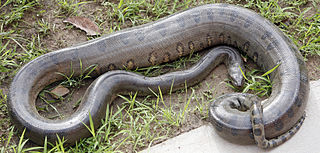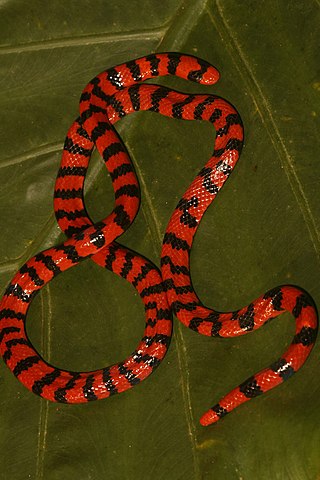
Anacondas or water boas are a group of large snakes of the genus Eunectes. They are found in tropical South America. Four species are currently recognized.

Eagle is the common name for many large birds of prey of the family Accipitridae. Eagles belong to several groups of genera, some of which are closely related. Most of the 68 species of eagles are from Eurasia and Africa. Outside this area, just 14 species can be found—2 in North America, 9 in Central and South America, and 3 in Australia.

Requiem sharks are sharks of the family Carcharhinidae in the order Carcharhiniformes. They are migratory, live-bearing sharks of warm seas and include such species as the tiger shark, bull shark, lemon shark, spinner shark, blacknose shark, blacktip shark, grey reef shark, blacktip reef shark, silky shark, dusky shark, blue shark, copper shark, oceanic whitetip shark, and whitetip reef shark.

Colubridae is a family of snakes. With 249 genera, it is the largest snake family. The earliest species of the family date back to the Oligocene epoch. Colubrid snakes are found on every continent except Antarctica.

Kingsnakes are colubrid New World members of the genus Lampropeltis, which includes 26 species. Among these, about 45 subspecies are recognized. They are nonvenomous and ophiophagous in diet.

Coral snakes are a large group of elapid snakes that can be divided into two distinct groups, the Old World coral snakes and New World coral snakes. There are 16 species of Old World coral snakes, in three genera, and over 65 recognized species of New World coral snakes, in two genera. Genetic studies have found that the most basal lineages have origins in Asia, suggesting that the group originated in the Old World. While new world species of both genera are venomous, their bites are seldom lethal; only two confirmed fatalities have been documented in the past 100 years from the genus Micrurus. Meanwhile, snakes of the genus Micruroides have never caused a medically-significant bite.

George Albert Boulenger was a Belgian-British zoologist who described and gave scientific names to over 2,000 new animal species, chiefly fish, reptiles, and amphibians. Boulenger was also an active botanist during the last 30 years of his life, especially in the study of roses.

The Leptotyphlopidae are a family of snakes found in North America, South America, Africa and Asia. All are fossorial and adapted to burrowing, feeding on ants and termites. Two subfamilies are recognized.

The Aniliidae are a monotypic family created for the monotypic genus Anilius that contains the single species Anilius scytale. Common names include the American pipe snake and false coral snake. It is found in South America. This snake possesses a vestigial pelvic girdle that is visible as a pair of cloacal spurs. It is ovoviviparous. It is non-venomous, and its diet consists mainly of amphibians and other reptiles. Two subspecies are recognized, including the nominate subspecies described here.

The sharpnose sevengill shark, also known as one-finned shark, perlon shark, sevengill cow shark, sharpsnouted sevengill or slender sevengill, is a species of shark in the family Hexanchidae, and the only living species in the genus Heptranchias. Found almost circumglobally in deep water, it is one of the few species of sharks with seven pairs of gill slits as opposed to the usual five. The other shark species with seven gill slits is the broadnose sevengill shark. Though small, this shark is an active, voracious predator of invertebrates and fish. When caught, this species is notably defensive and will attempt to bite. It is of minor commercial importance.

Nerodia is a genus of nonvenomous colubrid snakes commonly referred to as water snakes due to their aquatic behavior. The genus includes nine species, all native to North America.

Canthigaster is a genus in the pufferfish family (Tetraodontidae). A fish from this genus is sometimes referred to as a "toby" or a "sharpnose puffer".

The Atlantic sharpnose shark is a species of requiem shark in the family Carcharhinidae. It is found in the subtropical waters of the north-western Atlantic Ocean, between latitudes 43°N and 18°N.

Rhizoprionodon is a genus of requiem sharks, and part of the family Carcharhinidae, commonly known as sharpnose sharks because of their long, pointed snouts.

Hydromedusa is a turtle genus in the family Chelidae, commonly known as the South American snake-necked turtles. They are quite closely related to the South American side-necked swamp turtles (Acanthochelys) and the snake-necked turtles of the Australian-Melanesian region (Chelodina), but less closely to the spine-necked river turtles of South America (Podocnemididae) which belong to a more modern lineage of Pleurodira.
Ichthyapus is a genus of eels in the snake eel family Ophichthidae.

Apterichtus flavicaudus, variously known as the orange snake eel, sharpnose sand eel or sharpnose snake eel, is a species of snake eel native to the Indian Ocean from the Seychelles to Hawaii in the Pacific Ocean. It can be found at depths of from 7 to 293 metres being particularly common in shallow coastal waters with sandy substrates in near vicinity to reefs. This species can reach a length of 80 centimetres (31 in) TL.
The sharpnose sand eel is an eel in the family Ophichthidae. It was described by Keppel Harcourt Barnard in 1923, originally under the genus Sphagebranchus. It is a marine, subtropical eel which is known from Zululand and Durban in South Africa, in the western Indian Ocean. Males can reach a maximum total length of 40 centimetres (16 in).

Dipsadinae is a large subfamily of colubroid snakes, sometimes referred to as a family (Dipsadidae). They are found in most of the Americas, including the West Indies, and are most diverse in South America. There are more than 700 species.
















